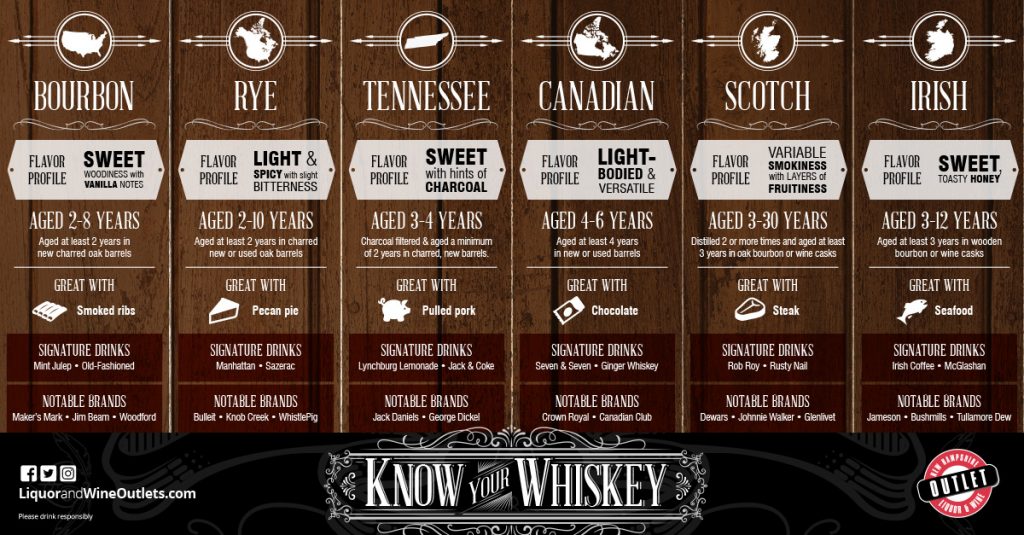While the world of whiskey/whisky (the different spellings explained below) is a very complex category. While we know there are a lot of savvy whiskey drinkers out there, we will attempt to streamline things a bit for those just gaining interest.
The word whisk(e)y roughly translates into “Water of Life” and that sounds good to us!
Our stores offer one of the largest whiskey selections in the country (!) and we invite you to explore our vast collection. We have, from the simplest whiskeys and blends to some of the rarest whiskey on the planet, with just about everything in between. Come and explore!
DEFINITION
Whiskey in simple terms is a distilled spirit made from fermented grain mash using wheat, corn, barley, or rye (or a combination of) and is typically matured in wooden barrels for some period of time. When the grain is “mashed” it releases the sugars that ultimately create alcohol. It is typically less than 95% alcohol (190 proof) and bottled not less than 40% ABV (alcohol by volume) or, 80 proof.
WHISKEY VS WHISKY
Both of these spellings are correct and simply just refer to the place of origin. The tricky part is knowing which is which. If it is made in Scotland, Canada, or Japan, the spelling – whisky is used. Irish and American products are called whiskey. The plural form of whiskey is whiskeys while the plural for whisky is whiskies or simply whisky.
PROOF
Alcohol proof is a measure of the content of ethanol (alcohol) in an alcoholic beverage. The United Kingdom originally measured proof using a complicated system of fractions of gravity, but they now use ABV measurements, while in the United States, alcohol proof is defined by twice the percentage of the ABV. Thus, an 80 proof bottling is 40% alcohol.
STYLES
Scotch Whisky (AKA Scotch, or in Scotland simply whisky)
The Scots have rigorous laws to govern the production of their heralded whisky. There are aging requirements of at least 3 years in a barrel, with an age statement on the label as to the youngest whisky in the bottle if it is a blend. It is made with either malt or grain mashes and they are known for their “peatiness” and smoky flavors, along of course, with massive complexity. Single malt scotch is the highest standard of production and needs to be made from a single batch and only one distillery. The main ingredient is malted barley.
Irish Whiskey
Irish whiskey has a smoother and cleaner profile without the distinctive peat and smoke of Scotch. It is made from a malt mash and can only use water and caramel coloring in it and must be distilled in casks for a minimum of 3 years. If you are not a fan of peat and smoky flavors in your whisky, try Irish.
Canadian Whisky
Canadian whisky is aged for at least 3 years in barrels and is lighter and smoother than many other types of whisky. Though Canadians refer to their own whisky as “rye” – as rye is a very flavorful addition – the blend itself is often made from a combination of wheat, barley, corn with typically very little rye.
Bourbon Whiskey
The category of bourbon is on fire! There is constantly more demand than availably for many of the top brands. Some brands that were easy to find just a few years ago, are now allocated to a scarce amount either monthly, or yearly. Bourbon is made with at least 51% of corn with the addition of rye and wheat depending on the style the producer is seeking and stored in charred, new oak barrels. Bourbons that contain wheat instead of rye, are known as “wheated bourbons.” Color is gained from the caramelized sugars and vanillin in the charred wood, and the longer the product is aged, the more color it attains. Straight bourbon must be aged for 2 years and bottled at 80 proof (40% alcohol) or more. If a product is simply labeled “bourbon whiskey”, rather than straight, (or blended), there are no aging requirements.
Rye Whiskey
Rye whiskey is made in America requiring at least 51% of rye in the final bottling which also allows corn and barley. As a main comparative feature, rye has a signature “spiciness” while bourbon is known for its caramel and sweeter notes.
Japanese Whisky
A newcomer in the whisky category, the Japanese created their product to taste as close to Scotch as possible (including the spelling) and do so with rigorously high standards of quality as the Scots do. Their distillation process also follows the general principles of Scotch production.
Blended Whiskey
As the name suggests, blended whiskies are made with different types of whiskey which are made mostly as a more affordable product that is often blended in cocktails giving the cocktail the flavor of whiskey, but at a much lower price point.
Where to Begin?
Because the styles and flavors of Whiskey are so diverse, it’s difficult to know where to begin. Sometimes just reading a review or a recommendation from a friend or bartender is all you need to give you a point of departure. Enjoying whiskey is typically an acquired taste and it will develop over time and will often lead you to a style preference. For instance, often people who love scotch, do not like bourbon, and vice versa. Everyone has their own taste preferences, and at the end of the day, only your opinion matters regarding what you like.
How to Drink Your Whiskey
There are many ways to enjoy your glorious golden liquid. Many hardcore aficionados prefer their whiskeys straight up in a rocks glass. Some prefer a glass made for this beverage that has a tulip shape that is also known as a chimney, that funnels the fragrances in the glass more readily to your nose. Some prefer ice; from one piece to several. A note of caution though, the more ice in your glass the fewer expressions you will taste, as the cold will mute the flavors. If you prefer lots of ice, we would suggest a more valuable brand product that still tastes good, but is not layered with complexity. You can also try it with a “flick” of water which opens the whiskey, much like a flower in the afternoon.
Whether you enjoy it straight up, with ice, or soda water, in a rocks glass, or a big wine glass to get the most out of the nose, it’s all about your preference. If you are tasting an expensive bourbon, try it neat first. Then try it with a flick of water, then a single piece of ice, and so on until you find your favorite way to enjoy it. The glass can make a huge difference! If you were to try a whiskey in a rocks glass straight up, and the same whiskey in a brandy snifter, believe it or not, they will often taste like completely different products. Whatever your preference, just make sure the glass is clean and dry before you pour it into it. You don’t want your expensive whiskey spoiled by the smell of residual dishwasher soap!
Where Should I Start?
If whiskey is something you want to get into but you don’t know what to buy, consider the following options.
Bourbon: Wild Turkey 101, Maker’s Mark, Evan Williams Single Barrel, Buffalo Trace, Old Forester, Eagle Rare, Elijah Craig, Four Roses.
Scotch Whisky: Dewar’s, Johnnie Walker Red or Black, Famous Grouse, Monkey Shoulder, Glenfiddich, Chivas Regal, Auchentoshan Select Single Malt.
Irish Whiskey: Jameson, Red Bush, West Cork, Tullamore Dew
Canadian Whiskey: Crown Royal, Collingwood, Canadian Club.
We hope you will use this simple guide to get you started on your journey. It’s a long and winding road of learning if you want to really get into whiskey, but certainly a fun one at that!
Slainte!

